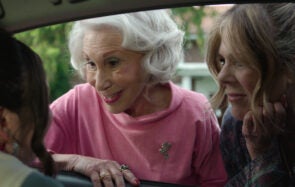We are in my garden surrounded by 200-year-old oak trees. My sprouting flower garden is to our right and my ambitious but reluctant vegetable patch, nothing but hopeful seedlings at this point in April, is just behind us. My beloved hens are huddling in the coop, wisely keeping well away of the running kids.
My seder is strictly BYOP: Bring Your Own Pillow.There are about 20 of us reclining on a thick Persian rug brought in from my living room while eating with our hands and sipping wine. The adults are fidgeting a bit against an aging bum knee or two, but have settled down. Perhaps the wine has helped. The kids are overwhelmed with the freedom to run and play without being told by their parents to stop. We will call them back during the service but we won’t force them.
READ: Why I Never Force My Kids to Kiss Their Grandparents (Or Anyone Else)
This is the seder that I’ve come to create for my family It is not like the seders of my youth: formal affairs with gold-trimmed Wedgewood china and the silverware from my great-great-great grandmother, row after row of formal glassware, dinner plates, dessert
plates, perfectly pressed napkins. The thought of it makes me sick.
The truth is that dinners at my parents’ house were not a happy time. Seders seemed to be even less so. It was not possible to make it through to the end of the meal before the shouting would start.
So it’s not really all that surprising that, when I looked for a house of my own as an adult, I avoided a formal dining room. And when confronted with the most table-intense holiday of them all—Pesach–I opted for a table-less option.
READ: How To Survive the Seder When You’re Depressed
The farther away from a table seder I moved, the closer I came to the meaning of the holiday itself. I now understand the luxury of reclining on mountains of pillows, and the hand-washing becomes a necessity rather than a symbolic gesture–especially for the kids. But it is the way I serve the food that really connected for me. I pile up trays of lamb, vegetables, and 10-hour eggs, and surround it with rice. Everyone eats with their hands, which is a big hit with the kids.
When food is served on a communal tray, it is a natural act for the server to point out what every item contains. It is exactly what we do with the seder plate, isn’t it? We point out what is on it. In the seder, we talk about the food and explain how it represents the Pesach story. By consuming the food, we consume the story. It becomes a part of us.
READ: Changing Up The Passover Seder, One Tradition at a Time
Communal eating also allowed me to enjoy the meal with everyone else. Normally at dinner parties I am running around serving food to everyone. But if you are eating with your hands, the food should not be piping hot. When we sit down, the food is already in place. All the work is done, and I am free to be part of the service without dashing to
the kitchen.
I have escaped my own form of slavery and now dwell, not in the Midbar, but in my backyard with everyone else, enjoying the holiday that, in my telling of it, has become more spiritual and meaningful to me.







